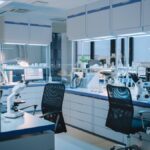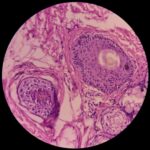No products in the cart
Peptide Synthesis

The Process of Peptide Synthesis
Solution Phase Synthesis (SPS) was the original approach to peptide synthesis. Though this process still has merit in this modern age, for large-scale peptide production, Solid-Phase Peptide Synthesis (SPPS) has become to be the method of choice of most scientists. SPPS’s advantages are the reason for this. SPPS appears to create peptides with higher purity, high yield, and faster production time.
There are five steps performed in a cyclical manner SPPS involves. The first step involves the attachment of an amino acid to a polymer. The second step is the protection of this attachment to prevent unwanted reactions. The next step is coupling the protected amino acids. Once that is done, they de-protect them to allow attachment acids to react to the following amino acid that will be added. And finally, they engage in polymer removal, allowing a free peptide to form.
Microwave-assisted SPPS can also enhance SPPS synthesis. This could be helpful when synthesizing long peptide sequences due to improved yield and speed. Microwave-assisted SPPS can, however, be the more expensive option compared to the traditional SPPS synthesis process.
Though SPSS can offer excellent purity and yield standards, it can still enable the development of impurities and imperfections during the process. The chances increase with a lengthier peptide sequence as more steps are needed to complete the synthesis process. Thus in order to secure optimal quality, specific purification techniques would need to be utilized. Examples would be:
- Reverse-Phase Chromatography (RPC)
- High-Performance Liquid Chromatography (HPLC)
Reverse-Phase Chromatography (RPC) is today’s most widely used peptide purification method. These purification methods can separate the impure peptides from the desired peptide. Thus benefiting peptides’ physicochemical properties.
Linking two amino acids together is how Peptides are synthesized. Most of the time, this is accomplished by attaching the C-terminus, or carboxyl group, of one amino acid to the N-terminus, or amino group, of another. Unlike protein biosynthesis, which involves N-terminus to C-terminus linkage, peptide synthesis occurs in this C-to-N fashion.
While there are 20 amino acids commonly occurring in the natural world, such as arginine, lysine, and glutamine, many other amino acids are also being synthesized. This creates abundant possibilities for the creation of new peptides. However, amino acids have multiple reactive groups that can negatively interact during synthesis. This could lead to unwanted truncating or branching of the peptide chain or cause suboptimal purity or yield. Due to these negative effects, peptide synthesis must be expertly carried out as it is a complex process.
Protecting Groups
Scientists have engineered special and specific chemical groups to secure the preferred outcome from the synthesis process and avoid extraneous, unwelcome reactions. To accomplish this goal, certain amino acid reactive groups must be deactivated or protected from reacting. These special groups are known as protecting groups and can be separated into three categories: N-terminal, C-terminal, and Sidechain. The N-terminal protecting group protects the N-termini of amino acids. Known as the temporary protecting groups, they are removed easily to aid the formation of peptide bonds. Two frequently used N-terminal protecting groups are:
- Tert-butoxy carbonyl (Boc)
- 9-fluorenyl methoxycarbonyl (Fmoc)
The C-terminal protecting group protects the C-terminus of amino acids. C-terminal protecting groups are needed in liquid-phase peptide synthesis but not solid-phase synthesis. Lastly, side chains various and unique protecting groups are needed to protect against unwanted reactions because amino acid side chains are conducive to reactivity during peptide synthesis. It can stay intact during the numerous cycles of chemical treatment during synthesis. These side-chain protecting groups are known as permanent protecting groups. Once peptide synthesis is done, side chains are only removed with strong acids.
Disclaimer: The products mentioned are not intended for human or animal consumption. Research chemicals are intended solely for laboratory experimentation and/or in-vitro testing. Bodily introduction of any sort is strictly prohibited by law. All purchases are limited to licensed researchers and/or qualified professionals. All information shared in this article is for educational purposes only.
Dr. Usman (BSc, MBBS, MaRCP) completed his studies in medicine at the Royal College of Physicians, London. He is an avid researcher with more than 30 publications in internationally recognized peer-reviewed journals. Dr. Usman has worked as a researcher and a medical consultant for reputable pharmaceutical companies such as Johnson & Johnson and Sanofi.





